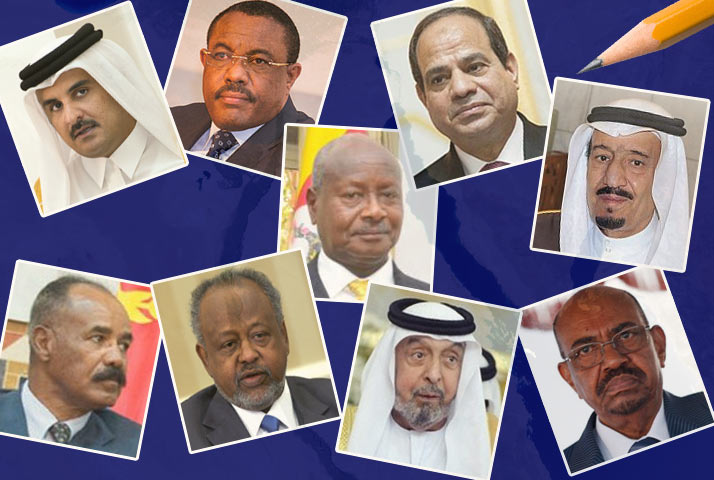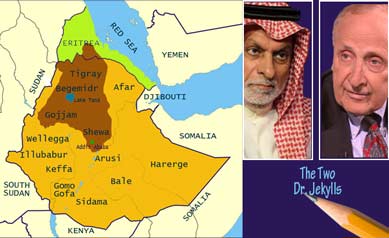The Dardanelles, The Nile, And The Red Sea

In December of 2010, Bouazizi, a frustrated Tunisian street vendor, set himself ablaze and soon died of his injuries. The immolation effectively depleted the tolerance capital of Tunisians and they toppled the 23-year dictatorship of Zen Al Abideen bin Ali. However, not many realized that the Tunisian uprising was the eye of the storm that would engulf all countries across the Middle East.
In February 2011, the popular uprising spread to Egypt and resulted in the overthrow of the 30-year dictatorship of Husni Mubarek. Spontaneous protests followed in many other countries and the spark ignited by Buazizi unraveled the many troubles of the region. That flame resulted in the current scenes of wreckage and chaos that is prevalent in the Middle East, from Libya, to Syria, to Yemen while the always present Palestine crisis has been put on the back-burner.
The countries of the Middle East and adjacent regions are no more what they used to be before the eve of 2011. Since then, many wars were ignited, hundreds of thousands of people were driven out of their destroyed homes, and the region is now littered with remains of body parts, of properties, and of shattered dreams that are moistened with blood, sweat, and tears. Meanwhile, the usual political manuals that were devised by European powers—particularly by Field Marshal Kitchner and Winston Churchill—for dealing with the Middle East, to distribute the territories of the Ottoman empire during WW1, are being dusted to be used again.
Incidentally, the only difference is that today Iran is a major player, with its fingerprints all over the region, unlike during WW1 when it hardly had any political significance except for its territories which the Russians and the British were conspiring to covet, and the “British India” government was a major “stakeholder”.
The current Middle Eastern alignments, realignments, and political joggling and jockeying have reached the Horn of Africa; every country in the region is exerting efforts to have a seat at the poker table. Naturally, some hold winning cards with Aces, while others are simply poised to lose with a small chance of winning. They are depending on luck, true to the tenets of gambling. However, as in any poker game, those with bottomless pockets can outlast the humble pocketed, even if they gamble with the lives of their people and the future of their country worth.
The Yemeni crisis has pulled the countries of the Horn of Africa like a ruthless magnet. Likewise, the major players of the Middle East are in turn pulled by the Syrian magnet. The merciless Russian big stick that lately showed its cruelty in Aleppo and proved its recklessness, has frustrated many governments and resulted in the nervous diplomacy that is going on.
Focusing on the Western coast of the Red Sea brings us to Eritrea, a country that straddles the Sudan to the West, Ethiopia to the South, and Djibouti to the East. The circle is enlarged to include other countries: Uganda, a Nile Basin country, Somalia, which is too close to ignore, and Egypt which sits on the mouth of the Nile which remained a source of anxiety and tension for more than a century, particularly between Egypt and Ethiopia.
In Ethiopia, the vision of the late Meles Zenawi to harness the Nile waters and transform Ethiopia into a major power producing country is being impressively realized. Recently Ethiopia inaugurated Gibe 3, one of the few biggest dams in Africa, which will double Ethiopia’s current power production, while the Great Ethiopian Renaissance Dam (GERD) that was wished dead on arrival, particularly by partisan Egyptian agitators, is only 30% away from completion.
The current Nile craze started with the toppling of the 30-year dictatorship of Mubarek and the election of Mohammed Mursi representing the Muslim Brotherhood (MB). Roughly a year later, Field Marshal Abdulfattah AlSisi toppled Mursi who had appointed him chief of the Egyptian Armed Forces. Since then, Egypt is going through a perpetual internal conflict. Mursi’s party, the MB, didn’t accept AlSisi as president, though he legitimized his presidency by an election after toppling the elected president. Other sectors of the Egyptian people who accused the MB of transgressions, and felt excluded and mistreated, particularly Egyptian Christians, liberals, and unaffiliated, threw all their weight behind AlSisi. Egyptians, mainly MB partisan cadres, are still using the Nile as an agitation card, and that seems to have forced AlSisi to rethink his Nile politics to ease the emotional public pressure.
In an interview with MBC Television in 2013, Yeweri Museveni, Uganda’s president (30 years in power), said, “I told the current president [Mursi], there was no Pharaoh, Turks, or the family of Mohammed Ali [Egyptian rulers] who ever visited the source of the Nile.”
On December 16, Egypt’s AlSisi finally made a one day visit to Uganda, the first by an Egyptian ruler since the time of the last Egyptian Pharaoh who ruled 4000 years ago. However, on the same day Ahmed AlKhatib, the Saudi king’s special adviser was visiting Ethiopia and made an unannounced visit to the GERD. Any of the two visits could have been a reaction to the other. In the end, the political rift between the two countries is not expected to be resolved anytime soon—the conflict first surfaced over difference on policies regarding Syria, then a scheduled trip to Saudi Arabia by the Egyptian prime minister in February was cancelled, that was followed in the same month by Saudi Arabia cancelling a planned investment in Egypt worth around $8 billion. The agreement included a five-year supply of oil to Egypt.
Saudi Arabia is heavily invested in two countries: Syria and Yemen. While the Yemeni conflict has pulled in both Sudan and Eritrea to varying degrees, the UAE is attempting to stretch its muscles in the region—according to unconfirmed reports—and it has established its presence in Assab, an Eritrean Red Sea port opposite to the Yemeni coast, and a stone throw away from Djibouti, the hub of international military bases. That, in addition to Iran’s real and perceived expansionist plans, has made the Gulf Arab countries nervous to secure their interests around Bab ElMendeb, the southern entrance to the Red Sea.
The Gulf Arabs had their differences over the years: Saudi Arabia and Qatar had a border issue, Qatar and Bahrain had a similar conflict over the Devil Islands that lay between the two countries, UAE has a major difference with Iran over the Abu Musa Islands. Only Kuwait is excepted from land disputes with its Gulf neighbors. However, they all know their interest is intertwined and they come together for the sake of self-preservation, in a fold led by the elder brother, Saudi Arabia. That is why the Gulf Arab countries are aligned behind Saudi Arabia in Yemen, in varying degrees—as far as they are concerned, the Yemeni conflict is essentially an existential conflict for all of them: it’s about stopping the expansion of the influence of Iran, their mortal enemy.
However, Sudan and Eritrea could only be involved in Yemen for the sake of financial rewards.Since the Nile straddles Sudan, its involvement is also motivated by existential reasons, while Eritrea has no significant Nile influence, but under Isaias Afwerki (25 year dictatorship) it can play a destructive role in the security arrangements of the region and would certainly be taken into consideration. Nevertheless, the above-mentioned countries are very concerned, their politics will depend on economic opportunities, safeguarding their investments, and the Nile waters—it boils down to the Nile, even as it evaporates. Around 80% of the Nile flows out of Ethiopia while the rest is from other countries such as Uganda.
In 2013, Saudi Arabia started in good terms with AlSisi, but recently their relations soured over Syria when AlSisi sided with the Russians. In addition, Egyptian sources claim that a recent deal between Saudi Arabia and Djibouti has further soured the Saudi-Egyptian relations, and that Egypt feels the deal was concluded behind its back when it should have been informed. Thus, as a counter-reaction, AlSisi invited Isaias Afwerki of Eritrea, who visited Cairo on November 28. Also, by the time this is published, the Qatari foreign minister should have arrived in Ethiopia for an official visit.
It is not a coincidence that, between October 14 and December 1st, the UAE received Isaias Afwerki of Eritrea (Oct. 14), followed by Omar AlBashir of Sudan (Nov.26) followed by Abdulfatah AlSisi of Egypt and Hailemariam Desalegn of Ethiopia (Dec, 1). Since summer, officials in Saudi Arabia, Ethiopia, Djibouti, and Egypt have been busy receiving heads of states and diplomats, and observers indicate that “the busy shuttling is expected to manifest itself in new alliances and probably new rifts.”
Qatar which has been supporting Isaias (25 years in power) of Eritrea seems to be having a second thought about its regional relations and has established a fast-growing relation with Ethiopia. Saudi Arabia has committed itself to considerable investment and is studying to have a stake in the Ethiopian economy, in agriculture and energy, particularly in the distribution of power and renewable energy projects. Djibouti is afloat because it managed to secure lucrative investments and to host almost all major military powers of the world. In addition, it has long replaced Assab port, Eritrea, as a major outlet for Ethiopian businesses and is successfully serving the Ethiopian economy and its 100 million strong population, by expanding its port facilities with specialized berths. Lastly, Sudan’s AlBashir (27 years in power) has perfected the skill of rope walking and is navigating the situation confidently, he managed to have balanced relations with Ethiopia, Egypt, and the Arab Gulf countries. And you do not need more information to determine who the biggest loser in the region is—it’s Eritrea as a result of its regime’s abysmal internal and external policies.
What happened to the Arab spring?
It turned out it is replaced by a gloomy Arab winter. In a recent interview with the Huffington Post, Wael Ghonim, the google computer engineer who launched the Egyptian facebook page that inspired the “Arab Spring” said, that social media is making people less keen on conversations and “more keen to broadcast opinions that mainly appeal to those who agree with them.” He adds, “Part of the Internet is being held captive by the less noble aspects of our human behavior. Today’s social media currency is likes, shares and retweets.”
Now post Bouazizi and post Wael Ghonim’s facebook revolution, most of the countries are bleeding, and are ravaged, and burdened by raging conflicts and human rights violations, and by tyrants who seem to be entrenched to stay forever. The miseries don’t seem to have an end. While some leaders are still playing brinkmanship with the fate of their people, others are tweaking their policies to benefit from the fast-paced regional developments. But this time, the wave that is hitting the shores of the region is not an experiment like the facbook inspired revolutions of 2011. The incidents of this month alone tells the future of the region: two suicide bombings killed about 100 people in Aden; another one killed close to 50 people in Istanbul; tens of thousands of civilians are being mercilessly bombed in Aleppo; and yesterday, as if adding the last straw to the load of the region, the Russian ambassador to Turkey was killed in Ankara.
It doesn’t look like 2011 at all, but more like the first weeks of WW1, when British and French ships attacked Turkey at the Dardanelles to dismember the Ottoman territories. This time, the dark clouds are looming over the region from the Dardanelles, the narrow waterway that separates Asia from Europe, to Bab ElMendeb, the narrow gateway that separates the Red Sea from the Indian Ocean.
Correction: the number of people killed in Istanbul were wrongly reported as close to 200.




Awate Forum